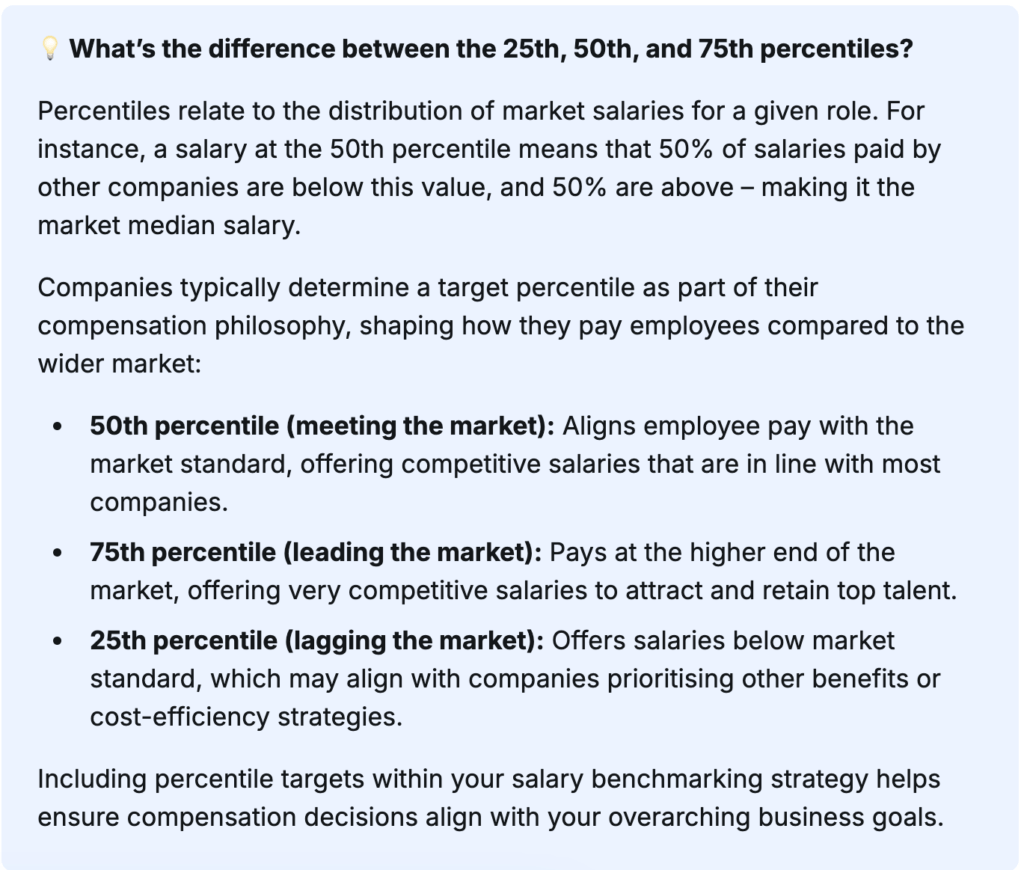Introduction
In today’s ever changing job market, salary benchmarking is crucial for effective compensation management. It involves comparing internal pay rates with market standards to ensure competitive and fair compensation across roles and industries.
Think of salary benchmarking as your organization’s guide in the complex world of compensation. It helps you make important decisions by providing clear insights into:
- Current market rates for specific roles
- Industry compensation trends
- Competitive positioning in the talent market
- Fair pay practices within your organization
For organizations in India, mastering salary benchmarking is essential for survival and growth in a competitive marketplace. With rapid economic changes and a highly skilled workforce, Indian companies must stay ahead of compensation trends to attract and retain top talent.
Effective salary benchmarking can turn raw data into strategic insights, enabling organizations to create strong compensation structures that align with business goals and meet employee expectations.
Understanding Salary Benchmarking
The salary benchmarking process in India follows a structured approach tailored to the unique dynamics of the local job market. Organizations typically engage in a systematic evaluation that includes:
- Job Role Analysis: Mapping internal positions against standardized job descriptions across different industries and sectors
- Geographic Considerations: Adjusting compensation data based on tier-1, tier-2, and tier-3 cities
- Industry Specific Focus: Analyzing sector-specific salary trends and compensation patterns
The benchmarking process relies on diverse data sources unique to the Indian market:
- Primary Data
- Salary surveys from HR consulting firms
- Direct competitor information
- Industry association reports
- Government labor statistics
- Secondary Data
- Online job portals
- Professional networking sites
- Company annual reports
- Public compensation disclosures
Data accuracy stands as a critical factor in the benchmarking process. Indian organizations must consider:
- Data Freshness: Salary information should be no older than 6-12 months
- Sample Size: Data should represent a significant portion of the target industry
- Market Relevance: Information must reflect the current economic conditions and industry dynamics
- Regional Variations: Data should account for significant pay differences across Indian states and cities
The Indian salary landscape experiences rapid changes due to factors like technological advancement, skill demands, and economic growth. Organizations need robust data validation processes and regular updates to maintain the relevance of their benchmarking efforts.
The Importance of Salary Benchmarking in India
India’s ever-changing job market has its own challenges that make salary benchmarking essential. The significant economic differences between tier-1, tier-2, and tier-3 cities result in large variations in pay scales across regions. For example, a software developer in Bangalore may earn 40% more than their colleague in Pune, emphasizing the critical need for location-specific benchmarking.
Why Companies Need Salary Benchmarking
Industries, especially technology and services sectors, are constantly evolving, leading to ongoing changes in pay scales throughout India. To keep up with these changes, companies must adjust their compensation strategies to:
- Address Skill Premium Variations: High-demand skills command premium salaries, with variations up to 50% above standard market rates
- Navigate Regional Disparities: Cost of living differences between metropolitan and non-metropolitan areas impact salary expectations
- Match Global Standards: Indian companies competing for international talent need aligned compensation packages
The Benefits of Structured Salary Benchmarking
Recent studies reveal that organizations implementing structured salary benchmarking experience:
- 25% reduction in employee turnover
- 35% improvement in offer acceptance rates
- 40% increase in employee satisfaction scores
The competitive nature of the Indian job market demands precise salary benchmarking to retain top talent. Companies that regularly benchmark their salaries to maintain competitive pay levels report stronger employer branding and enhanced ability to attract skilled professionals. This strategic approach helps organizations balance their budget constraints while ensuring fair compensation that reflects current market values.
Benchmarking Frameworks
In the Indian job market, salary benchmarking data serves as a foundational tool for People and HR teams to design well-structured and competitive salary band frameworks. These frameworks are tailored to specific roles, geographic locations, and hierarchical levels within an organization. For instance, a software developer in Bangalore may have a different salary band compared to one in Jaipur, reflecting the cost of living and demand for tech talent in these regions. Using benchmark data, HR teams can calculate critical percentiles such as the 25th percentile (lower quartile), 50th percentile (median), and 75th percentile (upper quartile). These percentiles provide insights into how salaries are distributed within the market. For example:
- 25th Percentile: Represents the lower end of the market pay range, suitable for entry-level or less experienced hires.
- 50th Percentile (Median): Indicates the middle of the market pay range, often used as a baseline for setting salaries for average performers or mid-level roles.
- 75th Percentile: Reflects the higher end of the market pay range, typically reserved for top performers or highly specialized roles.
By leveraging this data, HR teams can ensure that employee compensation aligns with fair market rates, thereby promoting pay equity within the organization. For instance, if a company discovers through benchmarking that their software engineers are paid below the 50th percentile in comparison to competitors in Bangalore, they can adjust their salary bands to remain competitive and retain talent.Additionally, salary benchmarking helps address regional disparities and ensures fairness across locations.
For example, while a marketing manager in Mumbai might require a higher salary due to the city’s higher cost of living, a similar role in Pune could have a slightly lower band. Such adjustments ensure that employees are compensated equitably based on their location while maintaining alignment with market standards.Ultimately, this approach not only fosters employee satisfaction but also strengthens an organization’s ability to attract and retain top talent in India’s diverse and competitive job market.

Salary Benchmarking Tools and Resources for Indian Companies
Indian organizations have access to several powerful salary benchmarking tools, each offering unique features and methodologies. Let’s explore the most trusted resources in the market:
Industry-Leading Tools
1. Mercer Total Compensation Survey
- Covers 500+ organizations across India
- Provides detailed compensation data by industry, role, and location
- Offers quarterly updates on market movements
- Best suited for large enterprises and MNCs
2. Radford Global Technology Survey (Aon)
- Specializes in technology sector compensation
- Features real-time analytics and custom reporting
- Includes equity compensation insights
- Ideal for IT companies and startups
3. Ravio Compensation Platform
- AI-powered compensation insights
- Real-time market data updates
- User-friendly interface
- Perfect for fast-growing companies
Tool Selection Criteria
Consider these factors when choosing a salary benchmarking tool:
- Data Coverage
- Number of companies in the database
- Geographic spread
- Industry representation
- Cost Structure
- Subscription fees
- Additional service charges
- ROI potential
- Update Frequency
- Real-time data availability
- Historical trend analysis
- Market movement tracking
Limitations to Consider
- Data lag in traditional salary surveys
- Limited coverage in niche industries
- Regional variations in data accuracy
- Cost barriers for smaller organizations
The right tool depends on your organization’s specific needs. Small businesses might benefit from cost-effective solutions like industry reports and local salary surveys, while larger corporations often require comprehensive platforms with advanced analytics capabilities.
Steps to Conduct Salary Benchmarking in India Effectively
Creating an effective salary benchmarking strategy requires a systematic approach. Here’s a detailed breakdown of the essential steps for Indian organizations:
1. Define Roles and Organizational Structure
- Map out job descriptions and responsibilities
- Create clear job levels and hierarchies
- Identify critical positions that need immediate benchmarking
- Document unique roles specific to your organization
2. Data Collection Strategy
- Select reliable data sources:
- Industry Compensation Surveys
- Professional networks
- Job market reports
- Recruitment portals
- Focus on region-specific salary data
- Consider company size and industry segment
- Include both base salary and total compensation details
3. Data Analysis and Market Alignment
- Clean and standardize collected data
- Group similar roles across different organizations
- Calculate key statistical measures:
- Median salary ranges
- 25th and 75th percentiles
- Mean compensation levels
- Factor in geographical pay differences
- Consider cost-of-living adjustments
4. Create Your Benchmarking Template
- Design a standardized format including:
- Job titles and descriptions
- Salary ranges
- Benefits and allowances
- Variable pay components
- Build flexibility for regular updates
- Include space for historical data tracking
- Add sections for industry-specific compensation elements
Remember to account for India-specific factors such as statutory benefits, variable pay practices, and allowance structures common in the Indian market. Regular monitoring and updates ensure your benchmarking remains relevant in India’s dynamic job market.
Future Trends in Salary Benchmarking for Indian Companies
The Indian compensation landscape is transforming rapidly, with several emerging trends shaping salary benchmarking practices through 2024 and 2025:
1. Skills-Based Pay Structure
- Companies are shifting from traditional role-based compensation to skills-based pay models
- High-demand skills in AI, machine learning, and data analytics command premium salaries
- Regular skill assessments influence salary adjustments and promotions
2. Personalized Benefits Packages
- Flexible compensation structures allowing employees to customize their benefits
- Mental health support, wellness programs, and work-life balance initiatives
- Remote work allowances and digital infrastructure support
3. Data-Driven Decision Making
- Real-time salary data analytics tools replacing annual benchmarking cycles
- AI-powered compensation management systems for dynamic market adjustments
- Predictive analytics forecasting salary trends across industries
4. Industry-Specific Changes
- IT sector: 20-30% salary growth expected for specialized roles
- Manufacturing: Integration of automation skills in compensation structures
- E-commerce: Performance-linked pay becoming standard practice
5. Employee Expectations
- Transparency in salary structures and benchmarking processes
- Greater emphasis on equity-based compensation
- Focus on total rewards including learning opportunities and career growth
The gig economy’s influence is reshaping traditional benchmarking methods, with companies developing hybrid compensation models that accommodate both full-time and contractual workforce needs. Organizations are increasingly adopting blockchain technology for transparent and efficient salary benchmarking processes.
Case Studies: Successful Salary Benchmarking Implementation by Indian Companies
Leading tech companies in India have transformed their compensation strategies through effective salary benchmarking. Let’s explore three remarkable success stories:
1. Infosys: Data-Driven Compensation Revolution
The IT giant implemented a comprehensive salary benchmarking system in 2021, resulting in:
- 20-30% increase in software engineer salaries
- Reduced attrition rate from 25% to 15%
- Enhanced ability to attract senior developers from competitors
2. Flipkart’s Role-Based Benchmarking Success
Flipkart’s targeted approach to role-specific benchmarking yielded impressive results:
- Product manager salaries aligned with 75th percentile of market rates
- 40% increase in successful tech talent acquisition
- Implementation of performance-linked pay structures
3. Freshworks’ Market-Leading Strategy
The SaaS company’s innovative benchmarking approach delivered:
- Competitive data analyst compensation packages
- Regular salary reviews every 6 months
- Introduction of equity compensation at all levels
These organizations demonstrate how strategic salary benchmarking transforms talent acquisition and retention. Their success stems from treating benchmarking as an ongoing process rather than a one-time exercise.
Conclusion
Salary benchmarking is a powerful tool for Indian organizations to stay competitive in today’s ever-changing job market. By strategically implementing benchmarking practices, companies can attract and retain top talent while ensuring employees receive fair and market-aligned compensation.
The success stories of Indian companies show the positive impact of effective salary benchmarking:
- Attracting talent through competitive pay structures
- Keeping employees happy with transparent compensation practices
- Becoming a preferred employer in the market
To achieve successful salary benchmarking, your organization needs to commit to:
- Regularly analyzing the market and collecting data
- Using the right benchmarking tools
- Creating structured compensation frameworks
- Continuously monitoring and adjusting pay scales
Now is the time to take action and improve your compensation strategy. By following the salary benchmarking practices in this guide, your organization can lay a strong foundation for growth and success in India’s competitive business landscape.
FAQs (Frequently Asked Questions)
What is salary benchmarking?
Salary benchmarking is the process of comparing an organization’s compensation levels against those of similar companies in the industry. It helps organizations understand competitive pay scales and establish fair compensation strategies.
Why is salary benchmarking important for organizations in India?
In India, salary benchmarking is crucial as it helps organizations maintain competitive pay levels across various industries, ensuring they attract and retain top talent in a competitive job market.
What types of data are used for salary benchmarking in India?
The types of data used for salary benchmarking in India include industry reports, job portals, traditional salary surveys, and external databases that provide insights into current pay scales and compensation trends.
What steps should be taken to conduct effective salary benchmarking in India?
To conduct effective salary benchmarking in India, follow these steps: Define roles to benchmark, collect relevant salary data from reliable sources, analyze the data to establish fair pay scales, and create a comprehensive salary benchmarking template for ongoing reference.
What tools are available for salary benchmarking in India?
Commonly used salary benchmarking tools for Indian organizations include Radford (Aon), Mercer, Ravio, Korn Ferry. Each tool has its advantages and limitations depending on the organization’s size, industry, and specific requirements.
How can successful salary benchmarking impact employee satisfaction?
Effective salary benchmarking can significantly enhance employee satisfaction by ensuring that compensation packages are competitive within the market. This leads to improved retention rates and a more motivated workforce.





